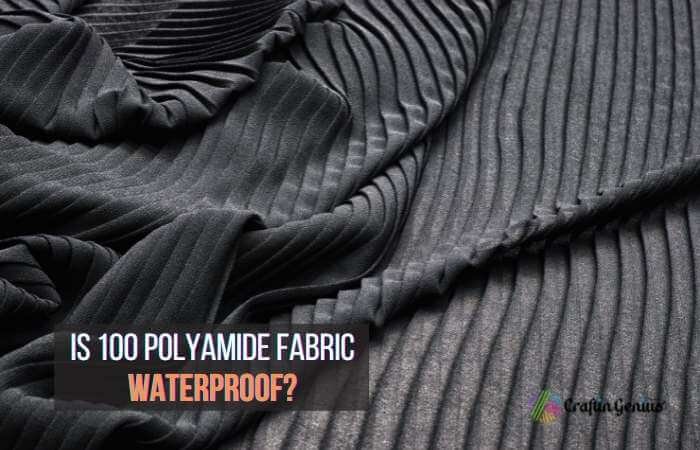Petroleum and chemicals are used to make polyamide textiles. Diamine acid is a kind of polyamide that is derived from oil products. Then it’s mixed with adipic chloride to make the nylon salts polymer.
Polyamide textiles, to put it another way, are materials manufactured from polyamide monomers. Nylon is an example of this fabric you’d be acquainted with; then, you already know how secure it is. This will also make you feel comfortable and warm.
We’ll discuss the following:
- Is polyamide water-resistant?
- What is the difference between waterproof and water-resistant jackets?
- Is water-resistant better than water repellent?
- Is 100 polyamide fabric waterproof?
- Is polyamide fabric safe to wear?
- FAQs

here is the brief answer Is polyamide water-resistant?
Polyamide, regardless of its design factors, is termed a water-resistant fabric. Polyamide is a hydrophobic plastic-based material utilized in various applications, including waterproof outerwear, cooking utensils, and sometimes even surgical implants.
Polyamide, commonly known as “nylon cloth,” is a plastic-based material comparable to polyester. Nylon or polyamide sheets are made using a complicated polymerization process that requires warming and condensing fossil fuels.
Therefore, the sheets are cut into minute fragments that are heated and spun into polyamide threads, which can subsequently be transformed into their exact shape suitable for its intended application.
As polyamide is a very versatile waterproof material that may be used for several purposes, including:
- Utensils for the kitchen
- Athletic wear
- Rugs
- Water-resistant Jackets
- Interiors of Vehicles
- Wrapping
- Mouthwasher
- Strings for Tennis Rackets
- Strings for fishing
- Gloves
- Surgical Implants
- Tents
difference between waterproof and water-resistant jackets
Waterproof and water-resistant materials have some differences between them. But people often wronged them, thinking that they were the same. So, in this case, I want to detail some of the differences between waterproof and water-resistant materials. So let’s see:
| Water-resistant | Water-resistant | |
|---|---|---|
| Wintry weather coverage | A water-resistant jacket provides adequate but insufficient coverage. | A waterproof jacket, on the other hand, provides the best wintry weather coverage. |
| Fabric | Water has a hard time getting through it with a water-resistant textile because it is so closely knit. The water-resistant garment, on the other hand, can only withstand so much rain. | Waterproof materials, for example, Polyester or nylon, inherently tolerate more moisture than cotton due to their structure. |
| Water barrier | The water-resistant just resist the water to come in. | The waterproof substance acts as a natural water barrier—for example, a plastic bag, they are really able to protect from a high level of water with great waterproof ability. |
| Protector | The water-resistant materials don’t have any membrane material. | Waterproof materials Use a kind of membrane material that is both waterproof and breathable. This membrane protects you dry from the inside (against sweat) and outside (from liquid and wet). |
| Impact of water | Capable of resisting moisture absorption to some extent but not totally | Unaffected to water |
Read also >> Can Leather Jackets Get Wet – [Waterproofing Tips]
Is water-resistant better than water repellent?
No, water repellent is better than water-resistant materials. However, there are some qualities and features that make water repellent is better than water-resistant materials.
Those qualities and characteristics are detailed below:
1. Water-resistant materials:
Water-resistant materials are the least with low levels of protection. For example, Suppose a gadget is classified called water-resistant. In that case, this indicates that its design makes it very hard for moisture to get in it and that this is treated with a far more light material that improves the item’s odds of getting a water contact.
Water-resistant properties are beneficial to watches since they allow them to endure light rainfall or hand cleaning.
2. Water repellent materials:
It is a level up with medium levels of protection than water-resistant materials. Water-repellent equipment, often known as hydrophobic equipment, has qualities that absorb moisture. Devices that resist liquid have a higher probability of recovering a wet encounter. Skinny nanotechnology, which may coat both the interior and exterior of an electrical device, is used by the majority.
Many products claim to be water-repellent. However, the word is hotly discussed due to the rarity of a long-lasting water repellent and the numerous uncertainties and unpredictable components that come with it.
is 100 polyamide waterproof?
Yes, regardless of its design features, polyamide is termed as 100% water-resistant fabric. When the end weight is more than the original weight, moisture absorption occurs, and nylon is no longer considered a waterproof fabric for specific design purposes.

Because These materials use a membrane material that is 100% waterproof with breathability, this membrane protects you dry from the inside against perspiration and outside from wet weather.
Is polyamide fabric safe to wear?
The ideal response is no. However, the substance has been issued since one of its byproducts is nitrogen, 350 times more harmful than co 2. In addition, as it can absorb more infrared light, it is 15-20 times more potent than methane. Then it takes at least three decades for polyamides to degrade naturally, and many of these items can last up to 250 years in cemeteries. That is harmful to both the environment and human health.
We haven’t even touched on the several toxic and harsh compounds utilized to make these materials, each of which carries its own set of dangers, including health problems. Furthermore, if your textiles end up in the seas, bigger fish will devour them and absorb all of the plastic contained inside them.
That’s not even a healthier choice for fish, which would affect the production of seafood. A variety of variables determines the number of hazardous substances absorbed through your skin. People with problem skin need to be more concerned than those with other skin tones about this problem.
FAQ about Is polyamide waterproof or water resistant
1. Is polyamide jacket water resistant?
Yes, the polyamide jacket is water-resistant. And It’s possible because the weaving pattern of polyamide materials has a significant impact. Polyamide is waterproof throughout the theory; however, if used in a jacket, fabric loses some of its resiliency due to the weaving type of the garment. So the most you can hope about is that the polyamide you’re wearing will keep you dry in the rains. So whenever it’s raining, use garments made of polyamide fibers with a tight weave to keep the water away.
Water will come in via an open weaving, perhaps slightly slower than some other materials, but it’ll go inside. The nylon’s strength will influence how waterproof this material is. In addition, if chemicals were applied to the components, the material had a strong possibility of becoming waterproof. There was a distinction to be made between shower proofing and waterproofing.
2. What material is most waterproof?
There are so many waterproof materials. But the Percentage of waterproof ability can vary from fabric to fabric. So let’s see some of the materials that are considered waterproof with their level of water protection:

Our verdict on Is polyamide waterproof or water resistant
Again coming to the main question, is polyamide waterproof? Yes, this fabric is considered a waterproof fabric.
But as a final word, I want to repeat something. Polyamide materials are poisonous and potentially dangerous to wear, yet soft, pleasant, and warmer. Having warm textiles such as these in the bag is a must if you’re going on a trip in the chilly mountains.
Based on where you acquire your cloth or apparel goods, they might not be pricey to purchase. Regardless of cost, these textiles are helpful when the weather becomes cooler.
Related articles:

Emily’s passion for crafting knows no bounds. She has spent years perfecting her skills, from mastering intricate knitting patterns to sculpting beautiful ceramics and everything in between. Her artistic talents have made her a force to be reckoned with in the crafting community.
